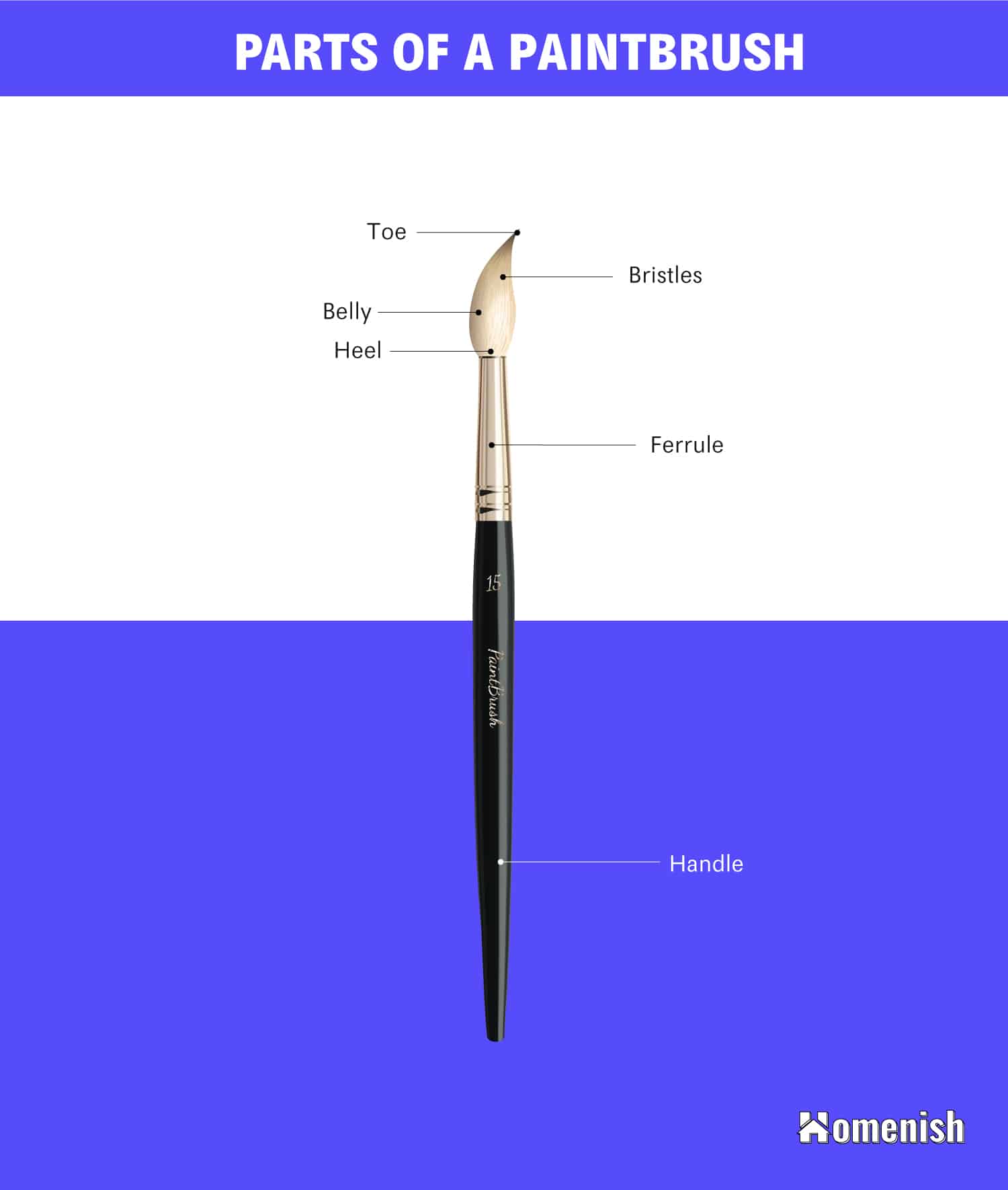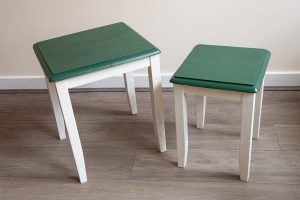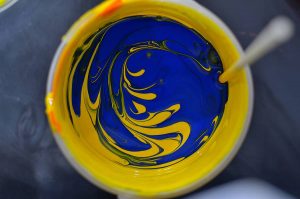A paintbrush is a tool used for applying paint. It is typically made by fastening the bristles to a wooden or plastic handle with the help of a ferrule. This tool can be subdivided into two categories, which are decorators’ brushes and artists’ brushes. Decorators’ brushes are used for applying paint on walls, while artists’ brushes are for visual arts purposes. Additionally, paintbrushes come in various types, shapes, materials, and sizes. Usually, thicker brushes are used for filling paint. Thinner brushes, on the other hand, are used for detailed painting tasks.
Here we’ll discover every major part of a paintbrush.

Handle
The handle of a paintbrush is the part you’re going to hold while you’re painting. It is typically made of wood, plastic, and metal.
Keep in mind that you need to consider the length and diameter of the handle when purchasing a paintbrush. To be specific, you must hold the handle to ensure that your proper grip and control while maneuvering the paintbrush.
In terms of length, a handle can either be long or short. Typically, paintbrushes with short handles can fit into your palm; thus, it allows different paint movement and applications. Paintbrushes with long handles, on the other hand, are preferred by most oil painters because it provides better balance.
Lastly, the size of the paintbrush is indicated on the handle. Usually, the size starts from 000 (smallest size) to 12 (largest size).
Ferrule
The ferrule is the part of the paintbrush that holds and connects the bristles to the handle. It can either be made of various metals, including aluminum, tin, copper, or brass allows which are chrome or nickel-plated.
In terms of quality, paintbrushes with copper or brass ferrule are preferred. The reason is that they are well glued to the handle. Plus, they have double or triple crimp, so you are ensured that the bristles will not fall off of the ferrule. Also, they are durable, and they don’t rust quickly even after several uses.
Bristles
The bristle is the part of the paintbrush that holds the paint, and it is the head of the paintbrush. Typically, the bristles’ quality determines the price of the brush.
Bristles are formed into various shapes, including flat, round, bright, angled, script filbert, mop, and fan. Aside from that, it can also be made with various materials, which includes the following:
Natural
Natural bristles are preferred if you’re going to apply acrylic or latex paint because they can provide a smooth finish. If you’re going to apply water-based paints, it is best to skip this type of bristle. The reason is that natural bristles can absorb water. If this occurs, the bristles won’t be able to hold or maintain their shape, leading to a major problem when you’re applying paint.
Ox and Hog Hair
The combination of ox and hog hair is not only durable. It can also hold more paint compared to a brush with hog or ox hair alone. Aside from that, this combination of natural bristles can produce a superior finish, making it a great paintbrush for applying varnishes, lacquers, and enamels. Unfortunately, this type of paintbrush is quite expensive compared to other brushes with natural bristles.
Synthetic
Synthetic bristles are ideal for water-based paints because they are water-resistant. As such, they won’t absorb water; thus, they are able to retain their shape. Aside from that, many painters opt for synthetic bristles because of their budget-friendly price.
Nylon
Nylon is the most popular type of synthetic bristles because they are extremely durable. However, this type of bristle is soft. As such, you can’t use it on rough surfaces because they may break, especially when used for extended periods. For this reason, nylon bristles are best for indoor application wherein you’re going to apply paint on smooth or semi-smooth surfaces.
Polyester
Polyester bristles are extremely water-resistant. As such, you don’t have to worry about them losing their stiffness. Plus, they can provide great control, so you’ll be able to apply paint with ease. Unfortunately, 100% polyester bristles will not be able to stand up to abrasive surfaces; thus, they will be damaged when used on a rough and textured surface. Aside from that, they also leave brush marks in the paint, so it will be difficult to get a smooth finish. Even so, this type of bristle is best for surfaces that are smooth, semi-smooth, and semi-rough.
Engineered Nylon
Compared to nylon bristles, engineered nylon bristles are stiffer. For this reason, you can use it for hard or rough surfaces without damaging the filaments. Additionally, they can maintain their shape even if you use them in humid or hotter areas.
Polyester and Nylon Blend
A paintbrush with polyester and nylon bristles offers the durability and softness of nylon bristles and the stiffness of polyester bristles. As such, this type of bristle can be used in all kinds of paint. You can also use it for outdoor or indoor applications without experiencing any problems. The only downside for this type of bristle is that it is hard to clean because of the polyester filaments.
Toe
The toe of the paintbrush is located at the tip of the bristles. It can either be flat, angled, round, and curved, depending on the shape of the bristles. Typically, brushes with a flat toe produce flat strokes. Those with a round toe, on the other hand, can deliver detailed marks.
Heel
The heel is the part of the bristle that is crimped or connected to the ferrule. You can also see this part if you disassemble the paintbrush.
Belly
The belly is the middle portion of the bristles. Usually, it is the part that holds the highest amount of paint.
When buying a paintbrush, always check the belly. As much as possible, opt for a paintbrush with a belly that is not too stiff. Additionally, it should not also flop around. Ideally, it should provide a pouncing feel to your hand.






